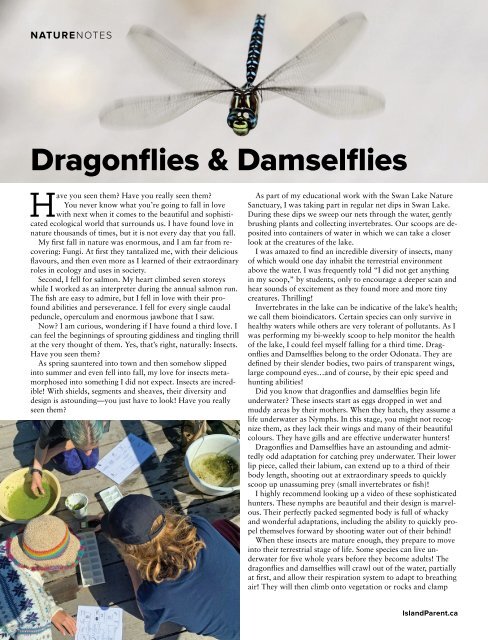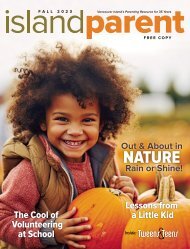Island Parent Magazine Dec-Jan 2023
Vancouver Island’s Parenting Resource for 35 Years • Holiday Gift Guide • Simplifying Your Traditions • 2022 Family Favourites • Holiday Happenings • GRAND: A Special Feature for Grandparents
Vancouver Island’s Parenting Resource for 35 Years • Holiday Gift Guide • Simplifying Your Traditions • 2022 Family Favourites • Holiday Happenings • GRAND: A Special Feature for Grandparents
Create successful ePaper yourself
Turn your PDF publications into a flip-book with our unique Google optimized e-Paper software.
NATURENOTES<br />
Dragonflies & Damselflies<br />
Have you seen them? Have you really seen them?<br />
You never know what you’re going to fall in love<br />
with next when it comes to the beautiful and sophisticated<br />
ecological world that surrounds us. I have found love in<br />
nature thousands of times, but it is not every day that you fall.<br />
My first fall in nature was enormous, and I am far from recovering:<br />
Fungi. At first they tantalized me, with their delicious<br />
flavours, and then even more as I learned of their extraordinary<br />
roles in ecology and uses in society.<br />
Second, I fell for salmon. My heart climbed seven storeys<br />
while I worked as an interpreter during the annual salmon run.<br />
The fish are easy to admire, but I fell in love with their profound<br />
abilities and perseverance. I fell for every single caudal<br />
peduncle, operculum and enormous jawbone that I saw.<br />
Now? I am curious, wondering if I have found a third love. I<br />
can feel the beginnings of sprouting giddiness and tingling thrill<br />
at the very thought of them. Yes, that’s right, naturally: Insects.<br />
Have you seen them?<br />
As spring sauntered into town and then somehow slipped<br />
into summer and even fell into fall, my love for insects metamorphosed<br />
into something I did not expect. Insects are incredible!<br />
With shields, segments and sheaves, their diversity and<br />
design is astounding—you just have to look! Have you really<br />
seen them?<br />
As part of my educational work with the Swan Lake Nature<br />
Sanctuary, I was taking part in regular net dips in Swan Lake.<br />
During these dips we sweep our nets through the water, gently<br />
brushing plants and collecting invertebrates. Our scoops are deposited<br />
into containers of water in which we can take a closer<br />
look at the creatures of the lake.<br />
I was amazed to find an incredible diversity of insects, many<br />
of which would one day inhabit the terrestrial environment<br />
above the water. I was frequently told “I did not get anything<br />
in my scoop,” by students, only to encourage a deeper scan and<br />
hear sounds of excitement as they found more and more tiny<br />
creatures. Thrilling!<br />
Invertebrates in the lake can be indicative of the lake’s health;<br />
we call them bioindicators. Certain species can only survive in<br />
healthy waters while others are very tolerant of pollutants. As I<br />
was performing my bi-weekly scoop to help monitor the health<br />
of the lake, I could feel myself falling for a third time. Dragonflies<br />
and Damselflies belong to the order Odonata. They are<br />
defined by their slender bodies, two pairs of transparent wings,<br />
large compound eyes…and of course, by their epic speed and<br />
hunting abilities!<br />
Did you know that dragonflies and damselflies begin life<br />
underwater? These insects start as eggs dropped in wet and<br />
muddy areas by their mothers. When they hatch, they assume a<br />
life underwater as Nymphs. In this stage, you might not recognize<br />
them, as they lack their wings and many of their beautiful<br />
colours. They have gills and are effective underwater hunters!<br />
Dragonflies and Damselflies have an astounding and admittedly<br />
odd adaptation for catching prey underwater. Their lower<br />
lip piece, called their labium, can extend up to a third of their<br />
body length, shooting out at extraordinary speeds to quickly<br />
scoop up unassuming prey (small invertebrates or fish)!<br />
I highly recommend looking up a video of these sophisticated<br />
hunters. These nymphs are beautiful and their design is marvelous.<br />
Their perfectly packed segmented body is full of whacky<br />
and wonderful adaptations, including the ability to quickly propel<br />
themselves forward by shooting water out of their behind!<br />
When these insects are mature enough, they prepare to move<br />
into their terrestrial stage of life. Some species can live underwater<br />
for five whole years before they become adults! The<br />
dragonflies and damselflies will crawl out of the water, partially<br />
at first, and allow their respiration system to adapt to breathing<br />
air! They will then climb onto vegetation or rocks and clamp<br />
34 <strong>Island</strong> <strong>Parent</strong> <strong>Magazine</strong> <strong>Island</strong><strong>Parent</strong>.ca
















